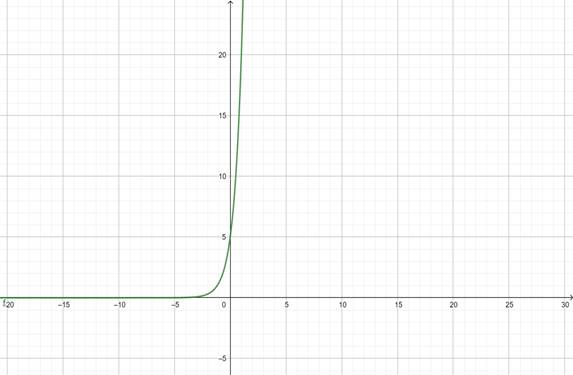
a.
To find: Whether the function is of exponential growth or decay
a.
Answer to Problem 19Q
The function is of exponential growth.
Explanation of Solution
Given:
Calculation:
The function is in the form of
And since
b.
To graph: The function
b.
Answer to Problem 19Q
From the graph, the domain is all real numbers and the range is
Explanation of Solution
Given:
Calculation:
From the function solve and plot some points on the graph.

The domain of a function is the set of points for which the value of function is defined and real. Thus, here the domain of the function is set of all real numbers. The range is
c.
To find: The yearly percent change and approximate monthly percent change.
c.
Answer to Problem 19Q
The yearly percent change is 300% and monthly is 12% approximately.
Explanation of Solution
Given:
Formula used:
Calculation:
For 0 year,
Now for 1 year,
Thus the yearly percent change is 300%
For monthly, Use
Therefore the equation becomes
Now use the growth factor
Therefore, the monthly percent increase is about 12%
d.
To find: The number of frogs after 4 years.
d.
Answer to Problem 19Q
The number of frogs in the pond after 4 years is 1280.
Explanation of Solution
Given:
Calculation:
For 4 year,
Thus, number of frogs in the pond after 4 years is 1280.
Chapter 6 Solutions
BIG IDEAS MATH Algebra 1: Common Core Student Edition 2015
- please Solve questions by Course Name( Ordinary Differential Equations II 2)arrow_forwardInThe Northern Lights are bright flashes of colored light between 50 and 200 miles above Earth. Suppose a flash occurs 150 miles above Earth. What is the measure of arc BD, the portion of Earth from which the flash is visible? (Earth’s radius is approximately 4000 miles.)arrow_forwarde). n! (n - 1)!arrow_forward
- Suppose you flip a fair two-sided coin four times and record the result. a). List the sample space of this experiment. That is, list all possible outcomes that could occur when flipping a fair two-sided coin four total times. Assume the two sides of the coin are Heads (H) and Tails (T).arrow_forwarde). n! (n - 1)!arrow_forwardEvaluate the following expression and show your work to support your calculations. a). 6! b). 4! 3!0! 7! c). 5!2! d). 5!2! e). n! (n - 1)!arrow_forward
 Algebra and Trigonometry (6th Edition)AlgebraISBN:9780134463216Author:Robert F. BlitzerPublisher:PEARSON
Algebra and Trigonometry (6th Edition)AlgebraISBN:9780134463216Author:Robert F. BlitzerPublisher:PEARSON Contemporary Abstract AlgebraAlgebraISBN:9781305657960Author:Joseph GallianPublisher:Cengage Learning
Contemporary Abstract AlgebraAlgebraISBN:9781305657960Author:Joseph GallianPublisher:Cengage Learning Linear Algebra: A Modern IntroductionAlgebraISBN:9781285463247Author:David PoolePublisher:Cengage Learning
Linear Algebra: A Modern IntroductionAlgebraISBN:9781285463247Author:David PoolePublisher:Cengage Learning Algebra And Trigonometry (11th Edition)AlgebraISBN:9780135163078Author:Michael SullivanPublisher:PEARSON
Algebra And Trigonometry (11th Edition)AlgebraISBN:9780135163078Author:Michael SullivanPublisher:PEARSON Introduction to Linear Algebra, Fifth EditionAlgebraISBN:9780980232776Author:Gilbert StrangPublisher:Wellesley-Cambridge Press
Introduction to Linear Algebra, Fifth EditionAlgebraISBN:9780980232776Author:Gilbert StrangPublisher:Wellesley-Cambridge Press College Algebra (Collegiate Math)AlgebraISBN:9780077836344Author:Julie Miller, Donna GerkenPublisher:McGraw-Hill Education
College Algebra (Collegiate Math)AlgebraISBN:9780077836344Author:Julie Miller, Donna GerkenPublisher:McGraw-Hill Education





